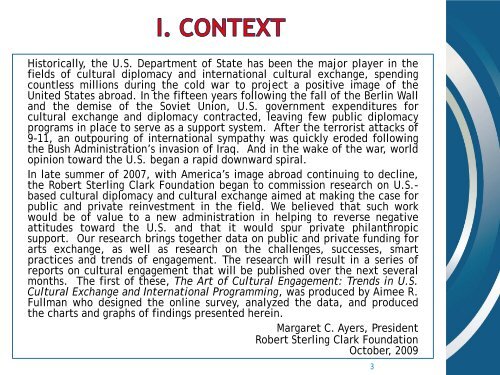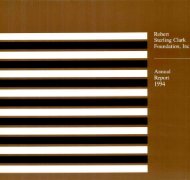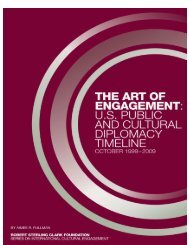Trends in U.S. Cultural Exchange and International Programming
Trends in U.S. Cultural Exchange and International Programming
Trends in U.S. Cultural Exchange and International Programming
You also want an ePaper? Increase the reach of your titles
YUMPU automatically turns print PDFs into web optimized ePapers that Google loves.
Historically, the U.S. Department of State has been the major player <strong>in</strong> the<br />
fields of cultural diplomacy <strong>and</strong> <strong>in</strong>ternational cultural exchange, spend<strong>in</strong>g<br />
countless millions dur<strong>in</strong>g the cold war to project a positive image of the<br />
United States abroad. In the fifteen years follow<strong>in</strong>g the fall of the Berl<strong>in</strong> Wall<br />
<strong>and</strong> the demise of the Soviet Union, U.S. government expenditures for<br />
cultural exchange <strong>and</strong> diplomacy contracted, leav<strong>in</strong>g few public diplomacy<br />
programs <strong>in</strong> place to serve as a support system. After the terrorist attacks of<br />
9-11, an outpour<strong>in</strong>g of <strong>in</strong>ternational sympathy was quickly eroded follow<strong>in</strong>g<br />
the Bush Adm<strong>in</strong>istration’s <strong>in</strong>vasion of Iraq. And <strong>in</strong> the wake of the war, world<br />
op<strong>in</strong>ion toward the U.S. began a rapid downward spiral.<br />
In late summer of 2007, with America’s image abroad cont<strong>in</strong>u<strong>in</strong>g to decl<strong>in</strong>e,<br />
the Robert Sterl<strong>in</strong>g Clark Foundation began to commission research on U.S.-<br />
based cultural diplomacy <strong>and</strong> cultural exchange aimed at mak<strong>in</strong>g the case for<br />
public <strong>and</strong> private re<strong>in</strong>vestment <strong>in</strong> the field. We believed that such work<br />
would be of value to a new adm<strong>in</strong>istration <strong>in</strong> help<strong>in</strong>g to reverse negative<br />
attitudes toward the U.S. <strong>and</strong> that it would spur private philanthropic<br />
support. Our research br<strong>in</strong>gs together data on public <strong>and</strong> private fund<strong>in</strong>g for<br />
arts exchange, as well as research on the challenges, successes, smart<br />
practices <strong>and</strong> trends of engagement. The research will result <strong>in</strong> a series of<br />
reports on cultural engagement that will be published over the next several<br />
months. The first of these, The Art of <strong>Cultural</strong> Engagement: <strong>Trends</strong> <strong>in</strong> U.S.<br />
<strong>Cultural</strong> <strong>Exchange</strong> <strong>and</strong> <strong>International</strong> Programm<strong>in</strong>g, was produced by Aimee R.<br />
Fullman who designed the onl<strong>in</strong>e survey, analyzed the data, <strong>and</strong> produced<br />
the charts <strong>and</strong> graphs of f<strong>in</strong>d<strong>in</strong>gs presented here<strong>in</strong>.<br />
Margaret C. Ayers, President<br />
Robert Sterl<strong>in</strong>g Clark Foundation<br />
October, 2009<br />
3






